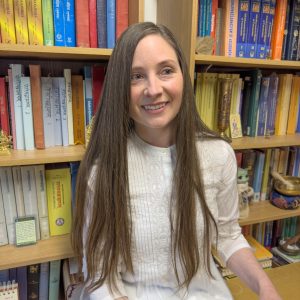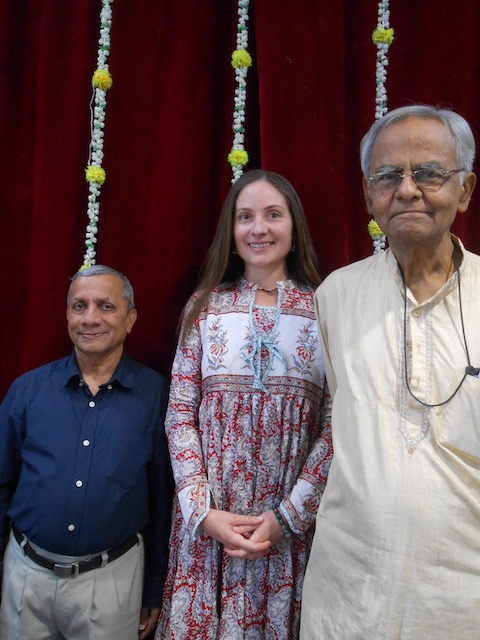
Tell us a little about yourself:
I was born and raised in California, but I have always been curious about how people in other places live and think. While studying political science and Spanish at UC Berkeley, I studied abroad three times. My family is Roman Catholic, so the Church has been a major influence and anchor in my life. Nevertheless, inspired by Ramakrishna, Huston Smith, and travel throughout the world, I have read the scriptures from all major world religions, spent time in different houses of worship, and experienced manifold spiritual practices. While doing an MA in Christian Spirituality at the Franciscan School of Theology, I started studying Sanskrit and working for DRBU’s Institute for World Religions. I went back to UC Berkeley to get an MA/PhD in Sanskrit, in the Department of South and Southeast Asian Studies, where I trained to be a specialist in the philosophy of the Brāhmaṇa texts and early Buddhism. When I finished in 2015, I started teaching at DRBU.
Despite a heavy teaching load, I try to keep up my research. Recently I wrote about how concepts of “travel” in the ritual practice of the Brāhmaṇa texts “traveled” in Indian thought up through colonialism. This semester I wrote a paper about Avalokiteśvara and another on Maurice Bloomfield that I will present at a conference on “Vedic Philology in the Twentieth Century” in May. I found out this week that I was awarded a Fulbright US Scholar fellowship to write my book on Vedic philosophy next year in India.
What inspires you to work at DRBU?
For me, the best part of working at DRBU is the freedom to incorporate contemplative exercises (CE) into the classroom experience. At DRBU, we don’t just read about meditation or how sages observe things in their mind theoretically; we also meditate and watch our minds. Then we can integrate what we notice from our direct experience into the shared inquiry. The contemplative exercises make the texts come alive. It brings me joy to see students light up when they reach a deeper understanding or discover something through this time-honored combination of study and practice.
For example, while discussing Skandhila’s Abhidharmāvatāra in the Abhidharma class, we recently did a CE on saṃjñā (conceptualization), which is both one of the five aggregates and a universal mental factor present in all moments of consciousness (citta). The text, in Dhammajoti’s translation, states that saṃjñā:
is that which comprehends, by combining conceptually (saṃ-√jñā) the appearance (nimitta), name (nāma) and the signified (artha) [of a dharma]. That is, with regard to matter like blue, yellow, long and short [figures], etc.; sounds like those of a conch-sell, a drum, etc.; smells like those of gharu-wood and musk etc., tastes like those of saltiness and bitterness etc., tangibles like those of hardness and softness etc., dharma-s like males and females, etc.—it comprehends them, [in each case], by conceptually combining together (eka-√jñā) their appearances, names and signification.1
After reading this definition from the text, I showed the class a blue panel and asked students to observe whatever characteristics, names, and meanings come to mind. Next, I showed a yellow panel, and everyone watched what arose in their minds. Finally, I held up an old, disintegrating bodhi leaf from Bodhgaya, and people again tuned into what that object triggered in their mind. At the end we shared our observations of the blue image, the picture of a yellow wall, and the bodhi leaf: color, size, texture, shape, definitions, memories, and other associations. Students were surprised that while some of the characteristics and associations were shared by the entire group, others were quite different and reflected the past experience of a particular individual. Part of basic Buddhist vocabulary, saṃjñā seems familiar, and yet the exercise helps students to directly connect to how this karmic condition informs their experience of objects.
In addition, I value the Contemplative Exercise Immersions (CEI) held for the entire university community every semester. DRBU takes a break from classes for a week so everyone can practice together a contemplative exercise featured in the readings of the curriculum. This hands-on laboratory provides a space for applying what is being learned in the classroom to one’s own experience. Each CEI helps students and faculty and staff to know themselves better, more deeply enter the wisdom of the texts, and activate inherent wisdom. This semester Venerable Bhikkhu Bodhi will lead a CEI on the four protective meditations!
Both the BA and the MA programs offer classical language study, which is appealing to me as a Sanskritist. I find approaching Dharma through Sanskrit and an Indian lens helpful to access meaning and deepen my understanding. English vocabulary is rather limited compared to Sanskrit. The same English word can be used for multiple Sanskrit words, so it’s easier to track how concepts relate in Sanskrit. I am also excited about the future possibilities of DRBU’s translation certificate program to train student-practitioners to make more texts available in different languages.
While I love that the undergrad program features classics from both the East and West, one of my favorite things to teach is Indian Classics. It is really fun to take students, most of whom have not read much if any Vedic philosophy, through hymns of the Ṛgveda, philosophical passages of the Brāhmaṇa texts, the Upaniṣads, Śaṅkara’s Vedānta, Sāṃkhya, Patañjali’s Yogasūtra, excerpts from the Mahābhārata, the Bhagavadgītā, and essays by Mahatma Gandhi and Swami Vivekananda. That’s just first semester. In the second, we read classical poetry and plays. In the third, we explore Jainism, the Goddess, Śaivism, and Sufism. The strand is colorful and rich, constantly challenging assumptions and preconceived notions in a playful way that introduces many different systems of Indian thought. The literature read in Indian Classics helps us understand, from multiple perspectives, who we are and how we relate to each other.

What motivates you as an individual?
I have an insatiable curiosity for philosophy and stories and enjoy trying to figure out complex patterns. That includes not just how ideas in ancient India developed, but also how my mind works. I enjoy teaching at DRBU because I get to deepen my understanding of multiple wisdom traditions that, in turn, help me to progress on the path. If I can help clarify things for others, then that makes me happy. I would like to be of service to others. Toward this end, I am motivated to understand more, to cultivate my mind, and to use whatever I gain in this endeavor to benefit others.
Do you have a spiritual practice? If so, can you share a little about it?
I am primarily a meditator, but a terrible one. My mind is rather active and doesn’t like to calm down. But I can see more of what’s going on than I could a few years ago, so even though I am not very proficient, I am not wasting the time I spend sitting every day. Because of my overactive mind, recently I have been working with ānāpānasati (mindfulness of breathing) and contemplation of the body. I observe what arises in my mind while training myself to see it for what it is. I also practice mettā as an antidote to anger and I recite a short mantra given to me by a sannyāsin. When other practices are offered in retreats and sessions, I take those up too. Practice is an essential part of my day.
What is your wish and hope for your students?
That depends on the student. In general, I hope that students enjoy the world’s classics, better understand the mind, learn to listen, see from different perspectives, and are inspired to benefit others. I hope that students learn tools to attenuate suffering, experience more joy, and mature in their study and practice until they awaken. An intellectual understanding alone is not enough. Likewise, one cannot just practice without understanding what one is doing and why one is doing it. A deep understanding of wisdom traditions results from putting these principles into practice. Otherwise, confused practice leads to obstacles and clinging to theoretical nonsense reinforces the ego. Time invested in deeply penetrating the meaning of inspiring texts and then arranging one’s life to realize their wisdom helps to activate one’s own.
1 Entrance into the Supreme Doctrine: Skandhila’s Abhidharmāvatāra, tr. Bhikkhu KL Dhammajoti (Hong Kong: Center of Buddhist Studies, University of Hong Kong, 2008), 80.